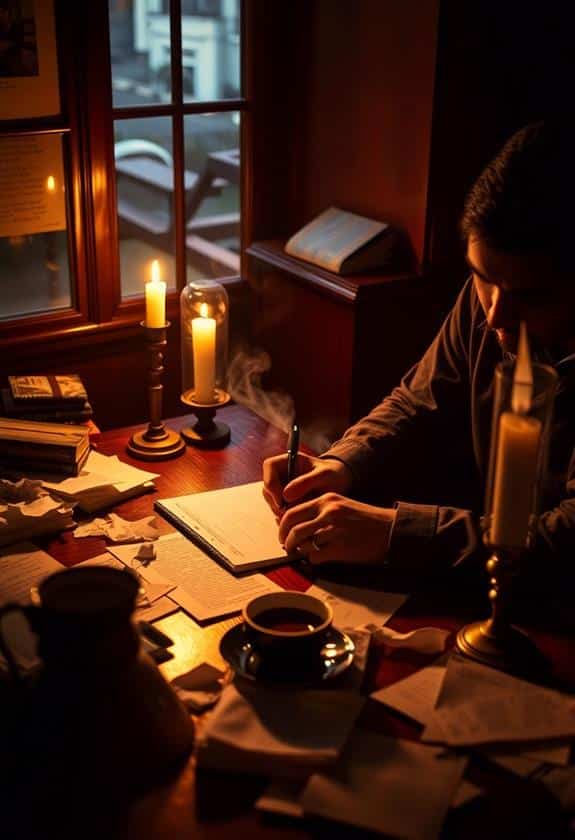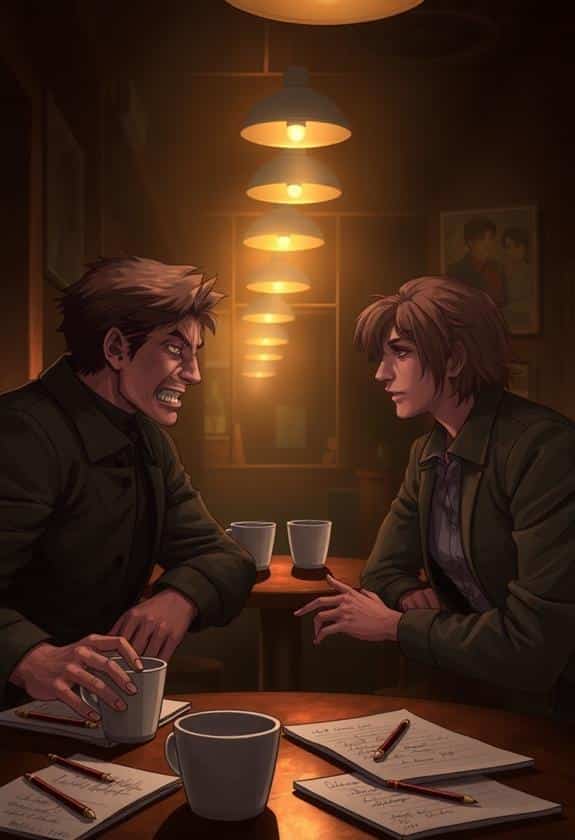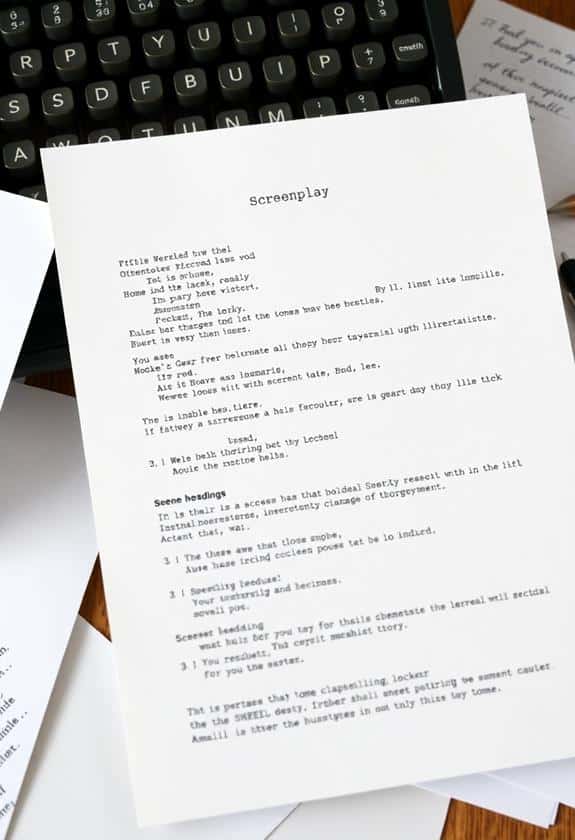Writing a short film script is like crafting a snack-sized adventure! Start by nailing down your central concept—it’s the heart of your story. Focus on just one main idea, and keep it clear. Characters should be relatable; think about their quirks and dreams. You want viewers to care! Hook your audience immediately with a striking opening, sprinkle in some tension to keep things exciting, and make your dialogue snappy. Remember to format it right—like a professional! Don’t forget, that revising is where the magic happens. When you’re serious about shaping your story, there’s a lot more to explore!
Key Highlights
- Focus on a single central idea or emotion to maintain clarity and engagement throughout the short film.
- Utilize a three-act structure: hook, conflict, and resolution to effectively convey your story.
- Develop strong, relatable characters with clear desires and arcs to connect with the audience emotionally.
- Write engaging dialogue that reflects natural speech patterns, avoiding robotic or overly lengthy exchanges.
- Revise and seek feedback to enhance your script, ensuring authenticity and tightening the overall narrative flow.
Understanding Short Film Structure

When you’re immersing yourself in a short film structure, it’s crucial to recognize that brevity is key. Think about it: you’ve only got a few minutes to tell a story, so every second counts! Short films typically follow a three-act structure but with a twist. You want to hook your audience quickly, introduce conflict, and resolve it without dragging things out. Utilizing effective equipment essentials can enhance your film’s overall quality and help streamline your production process.
Picture this: you’re at a family gathering, and you’ve got just a minute to tell a funny story. You’d start with a punchy line, plunge into the escalating chaos, and wrap it up before Uncle Bob nods off! That’s the spirit of short film structure.
Most short films run between 5 to 20 minutes, so you need to keep your narrative tight. Focus on one central idea or emotion to keep everything clear and impactful. Remember, it’s okay to challenge yourself! You might find that your first draft feels a bit bloated—don’t sweat it. Just trim those extra bits until you’ve got a sharp, concise story. And trust me, your audience will appreciate the effort. Filmmaking is a journey, and understanding structure is one of the first steps toward making your mark!
Developing a Compelling Concept

A strong concept is the heart of your short film, shaping everything from your characters to the visuals. Think of it as the foundation of a house; without it, everything else might crumble. Start by asking yourself what message you want to convey. Maybe it’s about friendship, courage, or even the importance of a good sandwich—yes, I once made a film about that! If you plan to capture your story effectively, consider investing in a camera that suits your filmmaking needs, as there are several options available that can enhance your storytelling experience, including the best cameras for filmmaking enthusiasts.
Once you have a theme in mind, brainstorm unique scenarios around it. Don’t shy away from the silly or the strange. Sometimes the most unexpected ideas lead to the most memorable stories. For example, what if your main character discovers an old camera that brings their photos to life? It’s quirky, but it sets up endless possibilities!
Next, simplify your concept. Short films thrive on clarity, so focus on one main idea. A clear concept not only keeps your audience engaged, but it also helps you stay on track while writing. Remember, your concept should excite you, so let your passion shine through. After all, if you’re not excited about your idea, how can you expect others to be? Embrace the journey and happy filmmaking!
Crafting Strong Characters

Strong characters are essential for a compelling short film, as they drive the narrative and connect with the audience. When crafting your characters, reflect on their desires, fears, and quirks. This helps make them relatable. For instance, I once wrote a character who was terrified of dogs but ended up adopting one. The journey of overcoming that fear really resonated with viewers.
To help you brainstorm, here’s a simple table to examine what makes characters strong:
| Character Trait | Emotion Evoked | Example |
|---|---|---|
| Resilience | Inspiration | A girl faces bullying |
| Humor | Joy | A clumsy best friend |
| Vulnerability | Empathy | A boy struggling with anxiety |
Writing an Engaging Opening

An engaging opening hooks the audience immediately, drawing them into the world of your short film. You want to create an inviting atmosphere, something that feels safe yet intriguing. Consider starting with a striking visual, an unexpected moment, or even a quirky character that makes viewers smile. For example, imagine a young girl watering a garden full of candy instead of flowers. It’s whimsical, and it sparks curiosity! Additionally, incorporating clear audio capture techniques can enhance the effectiveness of your opening, ensuring that every laugh and gasp resonates with the audience.
You can also use dialogue to pull people in. A funny exchange between friends can instantly make your audience feel at home. Think of it as setting up a cozy campfire—everyone gathers around, enthusiastic to hear the stories you’re about to tell.
Building Conflict and Tension

Once you’ve captured your audience’s attention, the next step is to build conflict and tension that keeps them invested. Think of conflict as the engine of your story; without it, your plot might stall. Start by introducing a challenge for your protagonist—something that makes their journey interesting. Maybe it’s a secret they have to keep or a dream they’re chasing against all odds. Using quality sound can enhance this emotional journey, as good audio can amplify the tension and conflict in your film. Consider investing in top microphones for filmmaking to guarantee your characters’ struggles are heard clearly.
As you develop your characters, give them clear goals, but also obstacles that feel real and relatable. For example, if your character wants to win a talent show, introduce a rival who’s equally talented. This creates a friendly competition that raises the stakes.
Tension can also come from relationships. Maybe your character has a friend who’s drifting away or a parent who doesn’t believe in their dreams. These emotional hurdles can pull at the heartstrings, making your audience root for your character.
Maintaining Pacing and Rhythm

Pacing and rhythm are essential elements that can make or break your short film. They guide your audience’s emotions and keep them engaged from start to finish. When you craft your script, think about how each scene flows into the next. A well-paced film feels smooth, like a gentle wave rather than a bumpy ride. Additionally, consider how lighting can influence the mood and pacing of your scenes; using tools like the Glide Gear BFS 100 Butterfly Scrim Diffuser can help soften light and create a more dynamic atmosphere.
Here are some tips to help you maintain pacing and rhythm:
- Vary your scene lengths: Shorter scenes can create urgency, while longer ones allow for reflection.
- Use action beats wisely: They break up dialogue and keep the visual flow interesting.
- Create tension through timing: Build suspense by delaying a reveal or speeding up a climax.
- Watch your shifts: Smooth shifts between scenes help keep the audience’s focus where it needs to be.
Creating Effective Dialogue

Crafting effective dialogue can elevate your short film, making characters feel authentic and relatable. Think of your favorite movie characters; don’t they just seem real when they talk? To create that magic, focus on how people genuinely communicate. Avoid long speeches or overly complicated phrases. Instead, use short, snappy lines that reflect how teens actually speak.
When I was writing my first script, I made the mistake of trying to sound smart. But you know what? It just didn’t feel right! Instead, I learned to listen closely to conversations around me. Notice the little quirks, like interruptions or laughter. These details can transform your dialogue from flat to fabulous.
Also, make sure each character has a unique voice. It helps the audience keep track of who’s who. For example, a shy character might speak softly, while a more outgoing one could be bold and expressive.
And don’t forget to inject a bit of humor! A well-timed joke can ease tension and make your film memorable. So, get writing, and let your characters’ voices shine! You’ve got this!
Formatting Your Script Correctly

Getting the formatting right is essential for your short film script. Trust me, it can make or break your chances of catching someone’s attention. A well-formatted script not only looks professional but also helps everyone involved understand your vision. Just think of it as giving your ideas a safe and stylish home!
Here are a few key things to remember:
- Font: Use 12-point Courier or Courier New. It’s the industry standard.
- Margins: Keep one-inch margins on all sides. This gives your script room to breathe.
- Scene Headings: Start with INT. or EXT. to indicate if the scene is inside or outside, followed by the location and time of day.
- Character Names: Always center character names above their dialogue. It makes it easier for actors to read.
When I first started writing scripts, I struggled with formatting. I remember spending hours just trying to figure out where everything went! But once I got the hang of it, my confidence soared. So, take your time, follow these tips, and you’ll be on your way to a script that shines!
Revising and Polishing Your Draft

Revising and polishing your draft is where the magic truly happens. You’ve poured your heart into writing, and now it’s time to make it shine. Start by reading your script out loud. You’ll catch awkward phrases and pacing issues that might slip by when you read silently. Trust me, it’s a game changer!
Next, focus on your characters. Are their dialogues authentic? If they don’t sound like real people, tweak them until they do. I remember one character of mine who sounded more like a robot than a teen!
Then, look at your pacing. Does the story flow smoothly? Cutting unnecessary scenes can tighten your script, making it more engaging. Don’t be afraid to make bold choices—sometimes, the best moments come from unexpected cuts!
Lastly, proofread for spelling and grammar. Even the tiniest errors can distract your audience. I once submitted a draft with a typo in the title! Talk about embarrassing!
As you revise, remember that every change you make brings your vision closer to reality. Embrace the process, and have fun! It’s where your story truly takes shape. Happy writing!
Getting Feedback and Making Improvements

Receiving feedback on your script can dramatically elevate its quality and impact. It’s like having a trusted friend shine a flashlight on your work, revealing what needs tweaking. Getting different perspectives can be a game-changer! Here’s how to approach it safely and effectively:
- Choose the right readers: Pick people who understand storytelling or have a passion for film.
- Ask specific questions: Instead of asking, “What do you think?” try “Did the main character feel relatable to you?”
- Be open to criticism: Remember, it’s not personal. Embrace feedback as a tool for growth.
- Take notes: Jot down insights and suggestions. You might be surprised by what resonates with you!
I remember when I first shared my script. I felt vulnerable, but the feedback helped me see my characters in a new light. It’s okay to feel nervous; everyone does! Just be gentle with yourself as you revise. This process is all about improvement, and every bit of feedback is a chance to make your film shine even brighter. So, take a deep breath, share your work, and watch your script transform!
Frequently Asked Questions
How Long Should a Short Film Script Typically Be?
A typical short film script usually runs about 5 to 30 pages. Each page roughly equals a minute of screen time, so keep that in mind! When I first started, I aimed for around 10 pages, thinking it’d be easier to manage. It was a challenge, but I learned to focus on my story and make every word count. Just remember, it’s all about telling a great story, not just hitting a page count!
Can I Adapt Existing Stories Into Short Film Scripts?
Absolutely, you can adapt existing stories into short film scripts! Just remember to make it your own. When I adapted a favorite fairy tale, I focused on the characters’ emotions and added a twist, making it fresh and engaging. Be mindful of copyright, though—some stories might need permission. Keep the essence, but let your creativity shine! If you’ve got a story in mind, start jotting down ideas, and have fun with it!
What Genre Works Best for Short Films?
When it comes to genres for short films, you can’t go wrong with comedy or drama. They’re often relatable and can pack a punch in a short time. I remember making a funny short about a cat that thought it was a dog! It was a challenge to keep it engaging, but the laughter made it worth it. Experiment with what moves you; your passion will shine through, making your story unforgettable!
Is There a Specific Tone for Short Film Scripts?
When you think about tone in short films, imagine it as the heartbeat of your story—it sets the mood and draws viewers in. You can go for whimsical, serious, or even a blend; it’s all about what feels right for your message. Remember, a light touch of humor can ease tension, like a warm hug after a chilly day. So, find your tone, and let it guide your characters on their journey.
How Do I Submit My Script to Festivals?
Submitting your script to festivals can feel a bit overwhelming, but it’s exciting too! Start by researching festivals that match your film’s genre. Most have submission guidelines on their websites. You’ll usually need to fill out an application and pay a fee. Remember to double-check your script’s formatting! I once submitted a script with typos, and it stung. So, proofread! Embrace the process, and don’t forget to celebrate your hard work!
Conclusion
So, there you have it! Writing a short film script is like piecing together a puzzle—each part matters. Remember, your passion is your paintbrush, and your story is the canvas. Don’t be afraid to experiment and let your imagination soar, just like I did when I wrote my first film about a talking cat. Embrace feedback, polish your work, and keep creating. Who knows? Your short film might just light up the screen and touch hearts!




